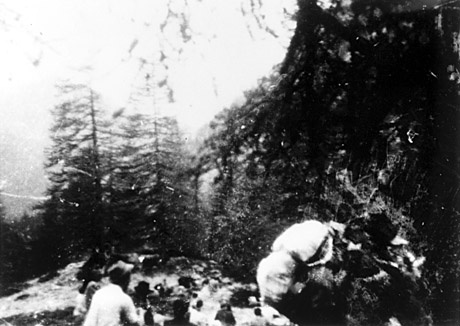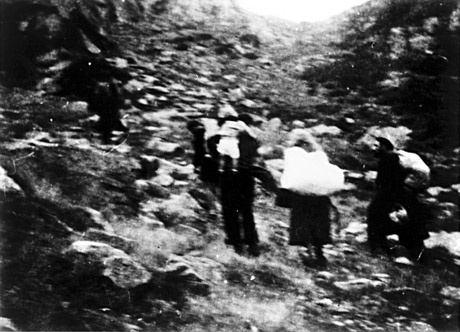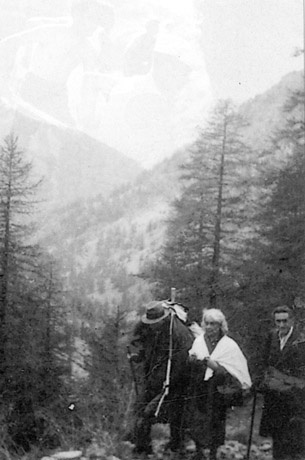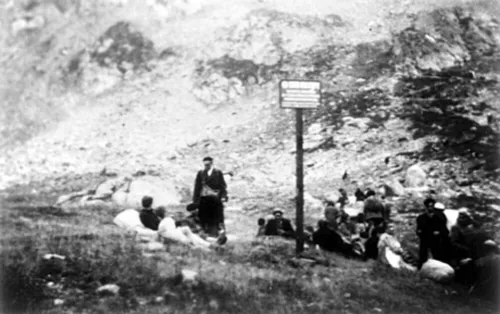
Saving oneselves
Between the 9th and the 13th of September 1943 nearly one thousand Jewish refugees coming from all over Europe, who had been kept by the authorities of Italian occupation within the residence forcée of Saint-Martin-Vésubie, crossed the Colle delle Finestre and the Colle Ciriegia in escaping from the Nazi genocide. Refugees from all over Europe, amongst whom a few months’ old babies and elderly people, walked down to Valle Gesso seeking for a refuge in Italy. The march “In through the memory”, now at its XVII edition, remembers their journey.

Lives in a trap
A family sitting at table eats a frugal meal. Worry, fear and tension are perceived. The mother makes for the endless time a thought explicit, a thought that is now an obsession or this is the first time it is discussed. The children do not understand, they guess, they know. Let’s go away from here, let’s escape. Mummy and daddy do quarrel, cry and embrace, reassure themselves.
Everything will be fine.
We have to try and imagine this scene, being aware that it has been happening millions of times in its innumerable types, firstly in Germany and so on through the lands the Nazi expanding policy did annex to the newly born empire. I do imagine it with the face of the refugee interpreted by Gad Elmaleh – the “gipsy” of Train de vie – in the 2010 movie that in Italy was on screen under the title Spring Wind, deriving it from the name of the large array intervention Nazi Germany put in place in Summer 1942 against Jews from different European countries. Among them, there were 13.152 persons that seven thousand collaborationist policemen captured between the 16th and the 17th of July, in Paris, in a major round-up – La rafle, the French title of the movie. The majority of them came to the Vélodrome d'Hiver, others to the Drancy transit camp. Less than one hundred survived to the genocide, amongst whom Joseph Weismann, the child whose story has inspired the movie, who before the catastrophe had a family, Polish Jews escaped into France, with whom he lived in the Montmartre district1. Joseph had no fear. Despite the fact that he had listened to his parents’ discussions endless times he did not understand what was going to happen2, and he would have lived for the rest of his life in feeling guilty: as it can be seen in the movie, it is his naïf behaviour to let his father discovered.
We have to try to imagine hundreds of thousands of families that, since the first times of February 1933 – with Nazism soon come to power – and for more than ten years, in turn took into consideration and enacted the choice of escaping from the racial persecution. Quite often coming to end into a trap, like the Weismanns, provided that great part of Europe did prove itself to be a closed case. And this is what happened to at least 331 refugees who, after having been kept by the Italian occupying forces within the residence forcée of Saint-Martin-Vésubie, left the French land in September 1943 together with the IV Italian army at its defeat. Together with hundreds of other refugees they passed hereby – where we stand today – seeking for protection in Italy. And on the 21st of November of the same year, they were deported to Auschwitz3.
A terrible secret?
Nazi anti-Semitism was already written down in Mein Kampf, the ideological manifesto that Adolf Hitler wrote in the mid 1920s. Two years after his raise to power, in 1935, the Nuremberg laws enforced it, then during the night between the 9th and the 10th of November 1938 there was the shift of the night of the broken glasses – the Kristallnacht –, an extremely violent pogrom, spontaneous only in appearance, that in Germany determined the anti-Semitic rage, destroying houses, stores, offices and synagogues and left on the ground thousands of Jews, deads and wounded. Since then, those who did not choose or could not afford the exile started to be deported as such to the Third Reich concentration camps. With the outburst of the war, Jews escaped from Great Germany were already four hundred thousand4, within an exodus that during its first years was not prevented by the Nazi hierarchy, rather strongly supported by: the last attempt at planning migration was made in Summer 1940 with the “Madagascar plan”, an incredible project of mass transfer of European Jews, that nowadays seems to us dramatically beyond reality and that has been summarized in the Eichmann in Jersusalem: A Report on the Banality of Evil by Hannah Arendt as follows:
The Madagascar plan was always meant to serve as a cloak under which the preparations for the physical extermination of all the Jews of Western Europe could be carried forward […] and its great advantage […] was that it familiarized all concerned with the preliminary notion that nothing less than complete evacuation from Europe would do - no special legislation, no "dissimilation", no ghettos would suffice. When, a year later, the Madagascar project was declared to have become "obsolete," everybody was psychologically, or rather, logically, prepared for the next step: since there existed no territory to which one could "evacuate," the only "solution" was extermination5.
Eichmann, that boasted the “Madagascar plan” as an own idea, would have come to claim that it was really the refusal from third countries to welcome those persecuted to force the commanders of Nazi Germany to finally plan extermination. The physical elimination of European Jews started to be realised in the deep East in Summer 1941, when, with the invasion of the Soviet Union, between 2800 and 3000 men of the Einsatzgruppen – the squadrons of death that joined the Wehrmacht in the military intervention, with this specific mandate – «killed more than 550 000 people, 50 000 from the 22nd of June up till the end of August, and 500 000 between September and December 1941 […] combining war violence with the “dirty job” of the genocide»6. Like Eichmann, also a few members of the Einsatzgruppen would have been put under trial – first of all, between 1947 and 1948, twenty four officials in the so called “Nuremberg minor trials” – and would have regularly made appeal to the presumed unconditioned obedience to orders – the Befehlsnotstand – determined by a situation of emergency that made responsibilities move up along the hierarchical ladder up till individuating an only guilty, and not any more in the world of the livings: the Führer. «The state of submission following an order » – according to the definition adopted by Primo Levi7 – would have entered into History like the “Nuremberg defense”. «The judges – Christian Ingrao writes –very quickly started challenging the lawyers of the detainees who held positions of responsibility in the mobile units of extermination to produce a single example of an individual who had been punished for refusing to kill. They could never produce a single case, which had ruled this idea out by the end of the 1950s, at least for the officers and the heads of section. As far as the rank and file were concerned, the thesis of the Befehlsnotstand remained an incantatory formula in great number of interrogations[…]»8. In those bloody lands where a great deal of the generalized murder took place where during war years Nazis expressly killed more than ten millions of people and none of them was «a soldier on real service»9, men not only lost their right to live, but also the «right not to kill»10. Those who were requested to or who wanted to do it were not a few: it can be estimated that the extermination machinery directly involved nearly four hundred thousand persons (the half of them not being of German nationality)11, some of them crossed a non return stage and found themselves to pull the trigger against undefended human beings at least once a day and for many months 12. For this reason too, the suppression of European Jews, which was already ongoing since more than six months, was certified by bureaucracy and was organized in details on the table of the Wannsee Conference, on the 20th of January 1942: the extermination project was to be extended to the whole Western Europe that was progressively occupied and its “savage” stage was too much expensive from an economic-organizational and psychological point of view. Moreover there were too many news, arriving directly to the attention of the families and of the fellow citizens of every nationality of those who, for working reasons, did take an active part to the extermination. How many persons were aware of what was going on? Walter Laqueur, one of the main investigators of the «terrible secret», limits every possible discussion: «A secret which is shared, even if not in details, by tens of thousands of persons is not a secret any more»13. Since then onwards who had to know knew it: the Allies, the Church, many ordinary men and women inside the larger and larger borders of the Third Reich14. That soon became a truly “concentrationary world”, with places apt at the extermination of European Jews. The one where the majority of those coming from the Western part of the continent arrived at has been carved in our history and in our collective memory: Auschwitz.
It is painful to realize how many persons let themselves being involved– in many ways – by the enacting of the “final solution” of the “Jewish question”, but we cannot avoid to do it, because looking through this history might help us in understanding why, day after day, Europe transformed itself into a giant trap for those men and women who tried by all means to save themselves, like the hundreds who passed by these mountains between the 9th and the 13th of September 1943.

Doors closing, doors opening
Do not forget it: when only obscure omens could be seen and still it was allowed, leaving the European continent was not an easy task at all. For this reason too, in the bulk of the ‘30s, as the Jewish Museum of Daniel Libeskind in Berlin tells with clear antideterminism, many chose to seek for a safe harbor in other areas of the continent like in France.
Even fascist Italy had been, for more than ten thousand Jews of Central-Eastern Europe, a land of refuge15. A precarious one, nowadays we know it16, because for many of them another history, another opening door would have never existed. Preceded by a violent propaganda campaign and in complete decisional autonomy, in the peninsula too, at the end of the 1938 Summer, the racial laws had entered into force, under some aspects even harsher than the Nuremberg German ones and inspired to the racist legislation already enacted in the colonies and by borderline Fascism17. Italy introduced a «segregationist regime», as such – thus recalling to the reader modern apartheid – Primo Levi, who had been writing that «the premonition of imminent catastrophe condensed like grumous dew in the houses and streets, in wary conversations and dozing consciences»18, has defined it. After the racial laws thousands of Jews started to leave from fascist Italy, starting with the “foreigners”, of whom nearly nine thousands were struck by the decree of expulsion of the 7th of September 1938 that launched a grotesque episode of rectifications, round-ups, prorogations and psychological pressures and that within six months was able to get rid of them or to make more than a half of them escape, despite the fact that many countries did not want them any more. Central-Eastern Europe was getting more dangerous and in spite of the many departures the incoming migratory pattern did not stop. Since Summer 1939 only the transit at embarking was allowed for foreign Jews, in order to escape by the sea19. Soon before, in July 1938, even a conference was summoned for the problem of the refugees at Evian, that had to come to an end with nothing at all. One of the most well known stories following the Evian Conference was that of a thousand of Jews who tried to reach the Avana, and then the USA, on the ship “St. Louis” from the Company Hamburg-America, whose journey– in June 1939 – after the interdiction of landing imposed by the Cuban authorities, soon turned into a nightmare followed with great interest by the international press and by a large public as no other similar event before then20. After weeks in the high seas the ship was compelled to return to Europe and the refugees were hosted at the eleventh hour by England, France, Belgium and The Netherlands21. Not a few of them would have met their own’s death in the concentration camps of Eastern Europe and for this reason too the story of the “St. Louis” would have become one of the symbols of the not caring attitude of third countries22 before extermination, and not only in those places reserved to the Jewish memory – like the Yad Vashem Museum in Jerusalem – but even in the federal capital city of the USA, at the United States Holocaust Memorial Museum of Washington23.
However nobody, in 1939 and then in the incoming years, could foresee the future, when – with the Nazi occupation and the raise to power everywhere of collaborationist regimes – the persecution of “rights” would have become a man hunting24.
Nowadays we know it: in the heart of continental Europe there would have not been a safe shelter at all – if not Switzerland, that would have refused one refugee out of twos 25 –, because the borders of the Nazi empire would have had an unbelievable expansion and together with them the policy of repression and extermination of the “opponents to the Reich”. Who was trying to become invisible or to disappear without leaving traces and who looked for peace or refuge in the residence forcée of the area of Italian occupation in the French territory or in Italy, could not yet know how things would have come to an end.
And it is also due to this reason that contemporarily to the dreadful reality of the more less “common” men who took part to the persecutions and to extermination and to those who tried by all means to keep the indifference, the behaviours of the thousands of persons who opposed themselves and who were able to say “no” have to be recalled. Like the well known and debated story of Denmark where men and women of all ages and social origin improvised a gorgeous rescuing operation by sea, letting escape to Sweden, on fishing boats and ships of any kind, more than six thousand persons considered “of Jewish race”26. Like the episode of the French villages of Le Chambon and Dieulefit which welcomed hundreds and hundreds of hunted persons27, and like in general the 25.685 cases of “The Righteous Among The Nations” – those non Jewish who saved Jews – recognized by the Yad Vashem of Jerusalem28 and all those who still have not been registered or who will always be anonymous. Let’s think to the many inhabitants of the places of Tetti Baut, Festiona, Bergemolo, Bergemoletto, Demonte, Rialpo, Moiola, Gorrè, Beguda, St. Antonio di Aradolo, Aradolo, San Michele di Cervasca, Andonno, who gave refuge to those who, amongst the Jews escaping through the Alps, did not manage to continue the walk towards Switzerland or to the areas already rendered free by the Allies29. As for the hundreds of men, women, old people and children who, twenty months after having marched through the Colle delle Finestre and the Colle Ciriegia, saved themselves, there were thousands of other persons who were brave enough to host them for a night, for weeks or even months, putting into peril everything, also their own life.
Without ever falling down into self-absolutory rhetorics or unuseful generalizations, I think that it is of fundamental importance to remember on such an occasion as the present one, those “just people” who were able to oppose and who in saving “the other” – the foreigner – saved themselves.
Speech given on the occasion of the march “In through the memory” - International meeting “Every remembrance is the present”, Colle delle Finestre, the 6th of September 2015.
Translated by Fiammetta Berardo

1 Weissmann has told his story in the book Après la rafle, Michel Lafon, Paris 2011. See also Joseph Weismann, une vie après le Vél d'Hiv, in “L'Express”, 15 September 2011 (http://www.lexpress.fr/culture/livre/joseph-weismann-une-vie-apres-le-vel-d-hiv_1030283.html). For a summary see Michel Laffitte, La rafle du Vélodrome d’hiver, 16-17 juillet 1942, Encyclopédie en ligne des violences de masse, published on the 9th of November 2009 (http://www.massviolence.org/La-rafle-du-Velodrome-d-hiver-16-17-juillet-1942, ISSN 1961-9898) and the pertaining bibliography.
2 «Les gendarmes français sont arrivés sur le coup de midi, se souvient Joseph Weismann, aujourd’hui âgé de 79 ans, à propos de ce 16 juillet 1942. Je n’avais pas vraiment peur. En fait, je ne me rendais pas vraiment compte… Par contre, je n’oublierai jamais le très fort sentiment d’angoisse qui se dégageait de mes parents et des adultes entassés dans le bus qui nous a emmenés au Vel’ d’hiv’». See Témoigner: la «mission sacrée» de Joseph Weismann, 21 July 2010 (http://www.hamodia.fr/article.php?id=1279).
3 See the outcomes of the research – which will soon be published – Oltre il nome, carried on by Adriana Muncinelli and Elena Fallo on behalf of the Istituto storico della Resistenza di Cuneo, that has newly given identity and a face to captured and deported Jews.
4 See the entry “Refugees” in Walter Laqueur (edited by), Dizionario dell’Olocausto, Einaudi, Torino 2004, Italian edition edited by Alberto Cavaglion (orig. ed. The Holocaust Encyclopedia, Yale University Press, New Haven 2001).
5 See Hannah Arendt, Eichmann in Jerusalem: A Report on the Banality of Evil, Viking Press, New York 1963, p. 78. In relation to the debated work of H. Arendt, of course I do agree with Browning’s thoughts, when he says that: «While Eichmann is not in fact the best example of the "banal bureaucrat", the concept is still valid for understanding many Holocaust perpetrators» (Cristopher R. Browning, Ordinary Men. Reserve Police Battalion 101 and the Final Solution in Poland, Harper Collins, New York 1992, p. 250).
6 Christian Ingrao, Believe and Destroy: Intellectuals in the SS War Machine, Polity, Cambridge 2013 (Croire et détruire. Les intellectuels dans la machine de guerre SS, Arthème Fayard, Paris 2010, pp. 225-6).
7 Primo Levi, I sommersi e i salvati, Einaudi, Torino 2007 (I ed. 1986), p. 44. Engl. transl. The drowned and the saved, Vintage International, New York 1989).
8 Christian Ingrao, Believe and Destroy, quoted (the same reflections upon the failed attempt to punish those SS who refused to shoot as referred to Nuremberg might be found in Hannah Arendt, Report on the Banality of Evil, quoted, p. 99).
9 See Timothy Snyder, Terre di sangue. L'Europa nella morsa di Hitler e Stalin, Rizzoli, Milano 2011 (orig. ed. Bloodlands. Europe between Hitler and Stalin, Basic Books, New York 2010), pp 10-18 e 461-7, where the author specifies the method by which he has been calculating the numbers of the “planned extermination” of civilians (a third of the nearly fourteen millions of deaths has to be attributed to the Soviets, he says, and more than a half of their total number died from starvation ). At pp. 227 and following the activity of the Einsatzgruppen is examined.
10 Jonathan Littell, Le benevole, Einaudi, Torino 2008 (orig. ed. Les bienveillantes, Gallimard, Paris 2006), p. 19.
11 It is the well known estimate by Dieter Pohl, who writes: «There is an estimate that between 150.000 and 200.000 Germans from the Reich participated in the Holocaust, especially in the murder of European Jews. It is my guess that the number of local forces had probably the same dimension, though on a much lower level of responsibility» (http://www.academia.edu/5273106/Collaboration_in_the_Holocaust_in_Hitlers_Europe_2012). This estimate has been reported to me by Professor Ingo Loose following his intervention entitled Il concetto e la rappresentazione dei carnefici da Norimberga agli anni Novanta, during the seminar Ripensare e insegnare il nazismo (Berlino, 3-8 dicembre 2013), organized by the Mémorial de la Shoah of Paris.
12 The example might be found in Christian Ingrao, Believe and Destroy, quoted, referred to «each of the 300 men who were active in Russia» (a person per day and for a six months’ time).
13 See the entry “Final solution, who knew about it and what was known”, in Walter Laqueur (edited by), The Holocaust Encyclopedia, quoted.
14 «I governi alleati, com'è noto, ne ebbero inequivocabile notizia da svariate fonti nella seconda metà del 1942», Giovanni Miccoli writes in I dilemmi e i silenzi di Pio XII. Vaticano, Seconda guerra mondiale e Shoah, Rizzoli, Milano 2007 (I ed. 2000), p. 6, a book reference can also be paid to as far as the Church’s awareness is concerned (pp. 4-15), in relation to which see too Susan Zuccotti, Il Vaticano e l'Olocausto in Italia, Bruno Mondadori, Milano 2001 (orig. ed. Under His Very Windows. The Vatican and the Holocaust in Italy, Yale University Press, New Haven and London 2001), pp. 108 and following. As an example and as far as “common Germans” are concerned see Eric A. Johnson, Karl-Heinz Reuband, La Germania sapeva. Terrore, genocidio, vita quotidiana. Una storia orale, Mondadori, Milano 2009, at pp. 78, 15, 321, 326, 328-9, 334-5, 418-9 (orig. ed. What We Knew. Terror, Mass Murder, and Everyday Life in Nazi Germany, An Oral History, John Murry, London 2005).
15 10.380 in paying reference to the article of Eugenio Sonnino, La conta degli ebrei, dalle anagrafi comunitarie al problematico censimento del 1938, available online at: http://www.demographics.it/public/file_23_1_2011.pdf.
16 See Klaus Voigt, Il rifugio precario. Gli esuli in Italia dal 1933 al 1945, La Nuova Italia, Firenze 1993 (orig. ed. Zuflucht auf Widerruf, Exil in Italien 1933-1945, 2 voll., Klett-Cotta, Stuttgart 1989-1993).
17 See Nicola Labanca, Il razzismo istituzionale coloniale: genesi e relazioni con l'antisemitismo fascista, in Marcello Flores, Simon Levis Sullam, Marie-Anna Matard-Bonucci, Enzo Traverso (edited by), Storia della Shoah in Italia. Vicende, memorie, rappresentazioni (2 voll.), Utet, Torino 2010, p. 209.
18 Primo Levi, The Periodic Table, Schocken Books, New York 1984 (orig. ed. Il sistema periodico, Einaudi, Torino 1975, p. 39).
19 See Klaus Voigt, Il rifugio precario, quoted, pp. 291 and following and Davide Rodogno, Il nuovo ordine mediterraneo. Le politiche di occupazione dell'Italia fascista in Europa, 1940-1943, Bollati Boringhieri, Torino 2003, pp. 438 and following. A few of these statements are also present in my ebook La nostra Shoah. Italiani, sterminio, memoria (Feltrinelli Zoom, Milano 2015).
20 In addition to the novel like account by Gilbert Sinoué, Una nave per l'inferno, Neri Pozza, Vicenza 2005 (orig. ed. Un bateau pour l'enfer, Calmann-Lévy, Paris 2005) see Diane Afoumado, Exil impossible. L'errance des Juis du Paquebot 'St-Louis', Ed. L'Harmattan, Paris 2005.
21 See in particular Ibid., pp. 175-86.
22 See Raul Hilberg, Carnefici, vittime, spettatori. La persecuzione degli ebrei 1933-1945, Mondadori, Milano 1994 (orig. ed. Perpetrators, Victims, Bystanders, Aaron Asher Books, New York 1992), pp. 189 and following.
23 I have been visiting both memorials, in 2010 and in 2011.
24 See, in particular, Michele Sarfatti, Gli ebrei nell’Italia fascista. Vicende, identità, persecuzione, Einaudi, Torino 2007 (I ed. 2000), pp. 113-308 and Id., “Prefazione” in Mario Avagliano and Marco Palmieri, Gli ebrei sotto la persecuzione in Italia. Diari e lettere 1938- 1945, Einaudi, Torino 2011, pp. V-IX.
25 «Terra d'esilio, di speranza ma anche di disperazione, la Svizzera accolse durante la guerra circa 300.000 profughi, pari al 7 per cento della popolazione nazionale. Di questi, 28 000 erano ebrei, ma almeno altrettanti furono respinti alle frontiere» (Claudio Vercelli, entry “Switzerland, network bordering on”, in Walter Laqueur, edited by, The Holocaust Encyclopedia, quoted). See also Silvana Calvo, A un passo dalla salvezza. La politica svizzera di respingimento degli ebrei durante le persecuzione 1933-1945, Zamorani, Torino 2010.
26 See Bo Lidegaard, Il popolo che disse no. La storia mai raccontata di come una nazione sfidò Hitler e salvò i suoi compatrioti ebrei, Milano, Garzanti 2014 (Countrymen. The untold story of how Denmark's Jews escaped the Nazis, of the courage of their fellow Danes – and of the extraordinary role of the SS, Alfred A. Knopf, New York 2013).
27 See in particular François Rochat, Andre Modigliani, The Ordinary Quality of Resistance: From Milgram's Laboratory to the Village of Le Chambon, Journal of Social Issues, 51/3 (1995) and the documentary by Alexandre Fronty and Guillaume Loiret entitled Dieulefit, le village des Justes (Francia 2010).
28 http://www.yadvashem.org/yv/en/righteous/statistics.asp (updated on the 1st of January 2015).
29 For a summary of the whole story, in addition to the documentary by André Waksman, 1943. Le temps d'un répit / Il tempo di una tregua (Francia-Italia 2009) and to the CD-ROM edited by Adriana Muncinelli Ebrei in fuga attraverso le Alpi (Regione Piemonte, 2007), see the following basic bibliography (thanks to the work of Elena Fallo): Harry Burger, Biancastella. Un partigiano ebreo durante la seconda guerra mondiale in Il presente e la storia, Istituto storico della Resistenza e della Società contemporanea in provincia di Cuneo, L’Artistica, Savigliano 2005; Alberto Cavaglion, Nella notte straniera. Gli ebrei di St. Martin Vésubie. 8 settembre- 21 novembre 1943, Aragno, Torino 2012 (I ed. 1981); Rosetta Scotti Douglas, Quarantacinque giorni nel campo di concentramento di Borgo San Dalmazzo in Quaderno n. 1 del CDEC, Milano 1961; Luca Fenoglio, Angelo Donati e la questione ebraica nella Francia occupata dall’esercito italiano, Zamorani, Torino 2013; Guido Fubini, L’ultimo treno per Cuneo. Pagine autobiografiche 1943- 1945, Meynier, Torino 1991; Jean-Marie Le Clézio, Stella Errante, Il Saggiatore, Milano 2000; Michael Robert Marrus, Robert O. Paxton, Vichy France and the Jews, Standford University Press, California 1981; Giuseppe Mayda, Ebrei sotto Salò. La persecuzione antisemita. 1943-1945, Feltrinelli, Milano 1978; Adriana Muncinelli, Even. Pietruzza della Memoria. Ebrei 1938- 1945, EGA, Torino 2006; Adriana Muncinelli, La deportazione ebraica in provincia di Cuneo, in Il libro dei deportati, Ricerca del Dipartimento di Storia dell’Università di Torino, under the supervision of Brunello Mantelli and Nicola Tranfaglia, vol. II, Mursia, Milano 2010; Jean-Louis Panicacci, L’occupation italienne. Sud- Est de la France, juin 1940- septembre 1943, Presses Universitaires de Rennes, Rennes 2010; Liliana Picciotto Fargion, Il Libro della Memoria. Gli ebrei deportati dall’Italia (1943-1945), Mursia, Milano 2002 (I ed. 1991); Léon Poliakov, Jacques Sabille, Gli ebrei sotto l’occupazione italiana, Edizioni di Comunità, Milano 1956; Nuto Revelli, Il prete giusto, Einaudi, Torino 1998; Davide Rodogno, Il nuovo ordine mediterraneo, quoted; Chaya H. Roth, La Shoah. Memoria e dialoghi famigliari, Fusta, Saluzzo 2014; Stella Silberstein (Simha Naor), Hotel Excelsior. Un diario sulle tracce del passato. 1945/46 in Il presente e la storia, Istituto storico della Resistenza e della Società contemporanea in provincia di Cuneo, l’Artistica, Savigliano 2012; Paolo Veziano, Ombre di confine. L’emigrazione clandestina degli ebrei stranieri dalla Riviera dei Fiori alla Costa Azzurra, Fusta, Saluzzo 2014 (I ed. 2001); Klaus Voigt, Il rifugio precario, quoted; Susan Zuccotti, Holocaust Odysseys. The Jews of Saint- Martin- Vesubie and their flight through France and Italy, Yale University Press, New Haven & London 2007.









